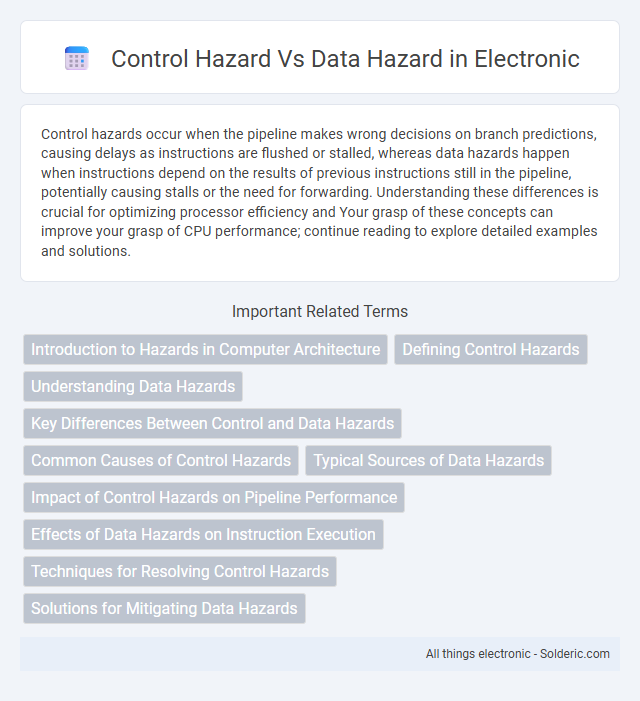Control hazards occur when the pipeline makes wrong decisions on branch predictions, causing delays as instructions are flushed or stalled, whereas data hazards happen when instructions depend on the results of previous instructions still in the pipeline, potentially causing stalls or the need for forwarding. Understanding these differences is crucial for optimizing processor efficiency and Your grasp of these concepts can improve your grasp of CPU performance; continue reading to explore detailed examples and solutions.
Comparison Table
| Aspect | Control Hazard | Data Hazard |
|---|---|---|
| Definition | Hazard caused by branch instructions affecting instruction flow | Hazard due to data dependency between instructions |
| Cause | Branch decisions or jumps altering program counter | Use of data before it is written or updated |
| Occurrence | During instruction fetch stage | During instruction execution and memory stages |
| Impact | Incorrect instructions fetched, leading to pipeline stalls | Incorrect data usage, causing hazards like RAW, WAR, or WAW |
| Types | Branch hazards, jump hazards | Read After Write (RAW), Write After Read (WAR), Write After Write (WAW) |
| Mitigation Techniques | Branch prediction, delayed branching, pipeline flushing | Forwarding, pipeline stalls, register renaming |
| Example | Branch instruction causing pipeline to fetch wrong instructions | Instruction depends on result of previous instruction not yet completed |
Introduction to Hazards in Computer Architecture
Control hazards occur when the pipeline makes wrong decisions on branch prediction, leading to instruction fetch delays and pipeline stalls. Data hazards arise when instructions depend on the results of previous instructions that have not yet completed, causing stalls or the need for forwarding techniques. Both hazards impact pipeline efficiency and require hazard detection and mitigation strategies in computer architecture.
Defining Control Hazards
Control hazards arise in pipelined processors when the flow of instruction execution depends on the outcome of a branch or jump, causing uncertainty about which instruction to fetch next. These hazards occur because the processor must wait to resolve the branch decision, potentially stalling the pipeline or fetching incorrect instructions. Unlike data hazards that involve dependencies between instruction operands, control hazards specifically relate to changes in the control flow affecting instruction sequencing.
Understanding Data Hazards
Data hazards occur when instructions that exhibit data dependencies are executed in close temporal proximity, causing conflicts in accessing or modifying shared resources such as registers or memory locations. These hazards are primarily classified into three types: Read After Write (RAW), Write After Read (WAR), and Write After Write (WAW), each impacting pipeline performance and instruction scheduling differently. Effective hazard detection and resolution techniques, like pipeline stalling and forwarding, are essential to maintain processor efficiency and prevent incorrect program execution.
Key Differences Between Control and Data Hazards
Control hazards occur when the pipeline makes wrong decisions about branch predictions, causing delays and pipeline flushes, whereas data hazards arise from dependencies between instructions that use the same data values. Control hazards typically impact program flow and require mechanisms like branch prediction and pipeline stalling, while data hazards affect data availability and are resolved through techniques such as forwarding or pipeline stalls. The fundamental difference lies in control hazards dealing with instruction sequencing, whereas data hazards focus on operand availability and data dependencies.
Common Causes of Control Hazards
Control hazards commonly arise from branch instructions that alter the program flow, causing pipeline stalls or flushes due to uncertain instruction fetch targets. Mispredicted branches and delayed branch resolution increase the frequency of control hazards, disrupting instruction pipeline efficiency. Techniques like branch prediction and delay slots help mitigate these hazards by reducing pipeline stalls in modern processors.
Typical Sources of Data Hazards
Typical sources of data hazards include read-after-write (RAW), write-after-read (WAR), and write-after-write (WAW) dependencies, which occur when instructions in a pipeline access the same register or memory location in conflicting orders. Control hazards arise from branch instructions that alter the flow of execution, causing pipeline stalls or flushes until the correct path is determined. Understanding these hazards is crucial for optimizing pipeline performance and ensuring your processor executes instructions correctly without unnecessary delays.
Impact of Control Hazards on Pipeline Performance
Control hazards, caused by branching instructions, significantly impact pipeline performance by stalling instruction flow and increasing latency. Pipeline flushes or delays occur while the processor determines the branch outcome, reducing overall instruction throughput. You can mitigate these performance losses through branch prediction techniques and speculative execution, enhancing pipeline efficiency.
Effects of Data Hazards on Instruction Execution
Data hazards occur when instructions that exhibit data dependencies affect the pipeline's normal execution, leading to stalls or delays as subsequent instructions wait for the required data to become available. These hazards disrupt instruction throughput and reduce overall CPU performance by causing pipeline bubbles or the need for forwarding mechanisms. Control hazards, however, primarily impact the pipeline during branching decisions but do not directly cause data waiting or resource conflicts like data hazards.
Techniques for Resolving Control Hazards
Control hazards occur when the pipeline makes incorrect decisions on branch predictions, disrupting instruction flow. Techniques for resolving control hazards include branch prediction schemes like static and dynamic prediction, branch target buffers (BTBs), and delayed branching to minimize stalls. Your processor's performance improves significantly by implementing these methods to reduce pipeline flushing and maintain instruction throughput.
Solutions for Mitigating Data Hazards
Data hazards, which occur when instructions depend on the results of previous instructions, are mitigated through techniques such as forwarding (or bypassing), where the processor uses the result as soon as it is available without waiting for it to be written back. Pipeline stalling, also known as bubble insertion, temporarily halts instruction execution to allow dependent data to become available, reducing the risk of incorrect computation. Compiler-level solutions like instruction reordering rearrange code to minimize pipeline conflicts, improving overall CPU performance and reducing the impact of data hazards.
Control hazard vs data hazard Infographic

 solderic.com
solderic.com